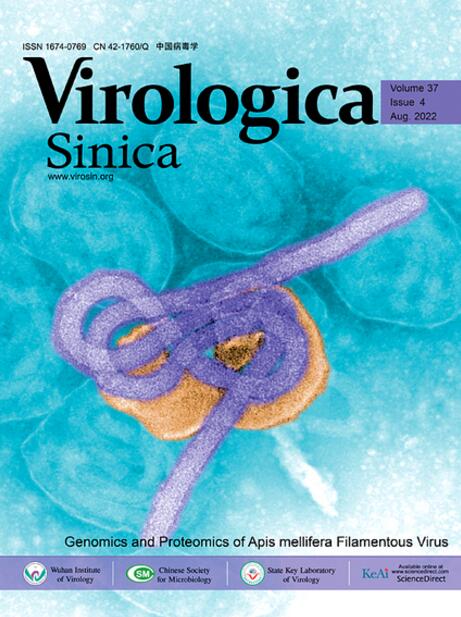Host factor Naf1 restricts HIV-1 infection of myeloid cells and compromises the capacity of dendritic cell to prime CD4+ T cell
IF 4
3区 医学
Q1 Medicine
引用次数: 0
Abstract
Naf1 (Nef-associated factor 1) is a host protein that interacts with human immunodeficiency virus type 1 (HIV-1) Nef protein. We and others have previously demonstrated that Naf1 restricts HIV-1 infection of T-lymphocytes. Myeloid cells are targets for HIV infection, but Naf1 expression in myeloid cells and whether it also regulates HIV infection in these cells are not yet identified. In this study, we found that Naf1 had a higher expression in CD14+ monocytes than in monocyte-derived dendritic cells (MDDCs), and its expression in both types of cells could be induced by HIV-1 gp120 glycoproteins or viral particles. Importantly, the expression of Naf1 restricted HIV-1 infection in monocytes and MDDCs. Functional investigation showed that both the constitutive and the induced expression of Naf1 inhibited NF-κB signaling in MDDCs and reduced the basal level or LPS (Lipopolysaccharide)-stimulated production of cytokines. Moreover, Naf1 reduced the expression of ICAM-1 (intercellular cell adhesion molecule-1) on MDDCs and compromised their capacity to prime the activation of resting CD4+ T cells in co-culture. In light of the essential role of NF-κB signaling for HIV-1 transcription, Naf1-mediated inhibition of NF-κB signaling may hinder a robust viral replication in MDDCs and help maintain viral persistence. Furthermore, virus-induced Naf1 expression in MDDCs may diminish the cross-talk between DC (dendritic cell) and T cells, hence suppressing the activation of antiviral immune responses. Taken together, we identified the new function of Naf1 in myeloid cells. Those findings may facilitate the understanding for the host restriction of HIV-1 infection in myeloid cells.
宿主因子 Naf1 限制了 HIV-1 对髓细胞的感染,并削弱了树突状细胞为 CD4+ T 细胞提供能量的能力。
Naf1 (Nef相关因子1)是一种与人类免疫缺陷病毒1型(HIV-1) Nef蛋白相互作用的宿主蛋白。我们和其他人之前已经证明Naf1限制HIV-1感染t淋巴细胞。髓细胞是HIV感染的靶点,但Naf1在髓细胞中的表达以及它是否也调节这些细胞中的HIV感染尚不清楚。在这项研究中,我们发现Naf1在CD14+单核细胞中的表达高于在单核细胞衍生的树突状细胞(mddc)中的表达,并且Naf1在两种细胞中的表达都可以被HIV-1 gp120糖蛋白或病毒颗粒诱导。重要的是,Naf1的表达限制了HIV-1在单核细胞和mddc中的感染。功能研究表明,Naf1的组成和诱导表达均可抑制mddc中NF-κB信号传导,并降低LPS刺激的细胞因子产生的基础水平。此外,Naf1降低了mddc上ICAM-1(细胞间细胞粘附分子-1)的表达,并削弱了它们在共培养中激活静息CD4+ T细胞的能力。鉴于NF-κB信号在HIV-1转录中的重要作用,naf1介导的NF-κB信号的抑制可能会阻碍病毒在mddc中的强劲复制,并有助于维持病毒的持久性。此外,病毒诱导的Naf1在mddc中的表达可能会减少DC(树突状细胞)和T细胞之间的串扰,从而抑制抗病毒免疫反应的激活。综上所述,我们确定了Naf1在髓细胞中的新功能。这些发现可能有助于理解骨髓细胞中HIV-1感染的宿主限制。
本文章由计算机程序翻译,如有差异,请以英文原文为准。
求助全文
约1分钟内获得全文
求助全文
来源期刊

Virologica Sinica
Biochemistry, Genetics and Molecular Biology-Molecular Medicine
CiteScore
7.70
自引率
1.80%
发文量
3149
期刊介绍:
Virologica Sinica is an international journal which aims at presenting the cutting-edge research on viruses all over the world. The journal publishes peer-reviewed original research articles, reviews, and letters to the editor, to encompass the latest developments in all branches of virology, including research on animal, plant and microbe viruses. The journal welcomes articles on virus discovery and characterization, viral epidemiology, viral pathogenesis, virus-host interaction, vaccine development, antiviral agents and therapies, and virus related bio-techniques. Virologica Sinica, the official journal of Chinese Society for Microbiology, will serve as a platform for the communication and exchange of academic information and ideas in an international context.
Electronic ISSN: 1995-820X; Print ISSN: 1674-0769
 求助内容:
求助内容: 应助结果提醒方式:
应助结果提醒方式:


